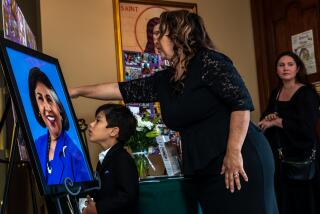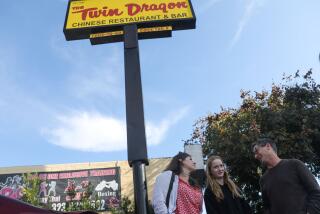Op-Ed: Two turtle doves and a pi-i-i-int of pig’s blood

For many years, when my children were young, we made our home in countries around the Mediterranean, following the children’s journalist father wherever his assignments took him, from Spain to France to Lebanon and Cyprus, and then to a farm in the mountains between Tuscany and Umbria. Christmas there was very different from what we’d known in America: low-key, quiet, family-focused. Over time we witnessed the slow invasion of stars and poinsettias, and strings of colored blinking lights. And then one year we spied the first Christmas tree displayed in the front room of the farmhouse next door, taking the place of the traditional creche. Santa Claus was coming.
Still, some things remained unaffected. Christmas here is the time when accounts get settled and great quantities of food get exchanged.
These are homegrown, home-produced foods. If Arnaldo gives Lorenzo a panpepato made by his wife, Lorenzo will give Arnaldo half a prosciutto cured by his own in return. Or a brace of sausages. Or a basket of eggs. Whatever comes from one’s own production, one’s own provender for the winter, whatever diminishes one’s own stock in favor of one’s neighbor — that is the object of the exchange.
During the decade when I spent most of my Christmases on that Tuscan farm, I dealt with it in my own way. The first year, what arrived on my doorstep — brought to me by Gino, who did occasional work for us — was a chicken. A large, living, breathing bird. It was tranquil, trusting, content to rest in my hands. I knew I had to kill it and I did not want to. Nor did I want to pluck it and especially I did not want to cook it. But we had to go back to Rome, where we lived during the school term, and there was no room in Rome for a Tuscan chicken. So I assassinated it — I will not horrify you with the method — and plucked and roasted it, dreading every moment, including when my teeth closed over the first reluctant bite. (Rubbed with new oil and garlic and roasted in the wood-burning oven, it was perhaps the best chicken I’ve ever cooked.)
The following Christmas, Gino’s successor, Bassetto (so called for his basset-hound dewlaps), arrived with a pristine pair of white turtle doves, the kind every farmstead used to maintain in a towered dovecote. This time the children were alert to the situation. “Murder those birds,” they announced, “and we’ll divorce you.” I found a friend, a Chianti winemaker, who willingly took the birds.
But far and away, the most problematic food gift I received in those days came from Mario Rossi. It was typical of the whole exchange ritual. The children and I had walked an hour to the Rossi farm, following a dirt track down into the valley, crossing a rickety wooden bridge. I brought with me a large panettone, one that had been made by hand in the finest local bakery. I knew it should have been something I had made myself, but this, I thought, was close enough.
“So what can I give you in return?” Mario said with a worried look. He wore, always, a greasy old fedora of an indeterminable color and when he was troubled by anything he would pull the brim down over his eyes while he contemplated his options. He did that now.
“A piece of pig’s liver?” I offered, knowing they had just slaughtered a pig and thinking I would happily make fegatelli.
“Mnn, mnn, mnn,” he said, wagging his index finger negatively. “I have to save that for mi povero fratello, my poor brother.” His poor brother was dying of la malattia cattiva, as they called cancer, reluctant to say the name outright. The pork liver, presumably, might restore Orlando’s strength. “A-ha!” Inspired, he disappeared into the cantina and returned with a quart Mason jar full of a darkly sloshing liquid. Pig’s blood.
“So what do I do with that?”
“Mita will show you,” he assured me, speaking of another neighbor.
And so she did, after I had carried the jar of blood back down the mountain, across the river, and up the other side. Sanguinaccio, Mita declared, blood pudding, a dish with antecedents that go deep into Tuscan history. Back even in Etruscan times, they slaughtered pigs during the cold months and made a pudding with the fresh blood.
Mita sat at the kitchen fireplace with a long-handled frying pan and melted pure white lard. She added a big handful of chopped onions to sizzle and soften, then a handful of raisins and an equal quantity of pine nuts. When those had turned golden she added, all at once, the full quart of pig’s blood, which bubbled and began to thicken. At this point, things got stranger: she stirred in a dozen or so crushed cavallucci, very hard, anise-flavored cookies, the kind you only eat by soaking them first in vin santo. A little sugar to sweeten the mixture, a little grated lemon peel to offset the sweetness, and then the whole thing cooked down, over the embers, until it was as thick as Christmas pudding, and oddly enough, just as delicious. And we ate every bit.
Nancy Harmon Jenkins, who divides her time between Tuscany and the coast of Maine, is the author of the forthcoming “Virgin Territory: Exploring the World of Olive Oil.”
Follow the Opinion section on Twitter @latimesopinion
More to Read
A cure for the common opinion
Get thought-provoking perspectives with our weekly newsletter.
You may occasionally receive promotional content from the Los Angeles Times.






